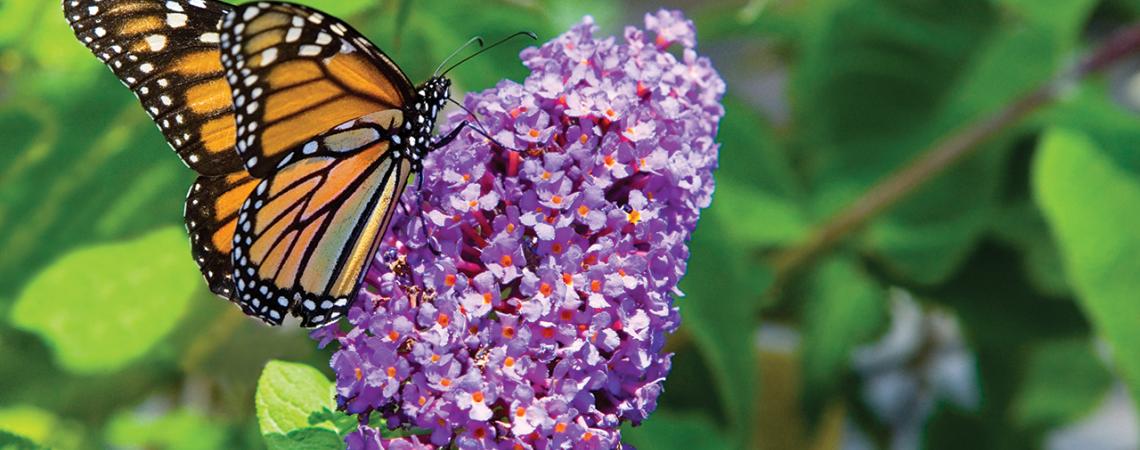Photo credit: Getty Images
Many gardeners fill their space with flowers to attract butterflies, but how would you like to have a garden where the complete life cycle takes place? You can grow and raise your own butterflies, from eggs to interesting caterpillars to the beautiful winged creatures. With the right habitat, you can enjoy lepidoptera all season long and even host the same species in your garden year after year.
Familiar and popular Ohio butterflies include the black swallowtail, the great spangled fritillary, the eastern tiger swallowtail, and the beloved monarch. If you’ve seen these butterflies in your neighborhood, you can plan a garden to attract them to your yard.
Most butterfly and moth species have defined needs for producing the next generation, and providing those requirements is the key to the perfect butterfly nursery. Butterflies love the sun, so your new garden (or chosen landscape bed) should ideally be in full sun. If that’s not possible, look for a space that receives at least six hours of afternoon sun. Keep in mind that newly hatched butterflies emerge from early spring until fall, so be sure to include nectar plants that are in bloom throughout the season.
The life cycle of a butterfly comprises three stages: egg, larva, and adult. The goal for your garden is to have all three, so that you can nurture each stage. Your first priority is providing plants for the adult females to feed on as they prepare to lay their eggs. A garden filled with flowers is important to attract those females, and knowing which nectar plants they prefer increases your chances for success. By also planting nearby “host” plants for newly hatched larvae, you’re ensuring that your butterfly ladies will stick around to fill the nursery.
The beautiful black swallowtail butterfly loves the nectar of butterfly bushes, zinnias, marigolds, pincushion flower, and dame’s rocket, but she will only lay her eggs on dill, celery, parsley, carrot, or Queen Anne’s lace. Plant attractive nectar flowers near your herb or vegetable garden or add Queen Anne’s lace or dill to an existing flower bed.
The great spangled fritillary and the smaller regal fritillary adults are partial to privet, zinnia, asters, bee balm, milkweed, and butterfly bush. This butterfly species lays her eggs only on violets. Violets grow low to the ground, so you can tuck them under the branches of a butterfly bush or among the zinnias, and the fritillaries will find them when they are ready to lay eggs.
Eastern tiger swallowtail butterflies are the most common swallowtail in Ohio. They’re also drawn to the butterfly bush, but lay eggs on yellow poplar and wild cherry. If you have such a tree on your property, consider putting in a nectar garden nearby to encourage the adults to stay in your yard. If you don’t have these trees but see eastern tiger swallowtails on a regular basis, then be sure to provide nectar sources for the females, even though you probably won’t see a caterpillar or cocoon.
Monarch butterflies are the darlings of the garden, and butterfly lovers are thrilled to find them in their flower beds. The most well-known of migratory butterflies, they travel from your Ohio garden to Mexico and back north again within their nine-month life span. The adults love the butterfly bush and other flowers, but to have monarchs raised in your garden, you must plant milkweed — the only host plant for monarch larvae.
All types of milkweed qualify, but the most frequently used are common milkweed (Asclepias syriaca) and butterfly milkweed (Asclepias tuberosa). A bit of advice: These plants can take over quickly, so you might want to have a special bed just for the monarchs, so that you can control the milkweed. Planting a butterfly bush in the same bed with the milkweed provides an adult food source, a host plant for eggs, and a larval food source.
Many other butterflies abound in Ohio, as well — painted lady, buckeye, mourning cloak, viceroy, red admiral, and many varieties of skippers. A little extra research will help you include those beauties in your new butterfly garden.









